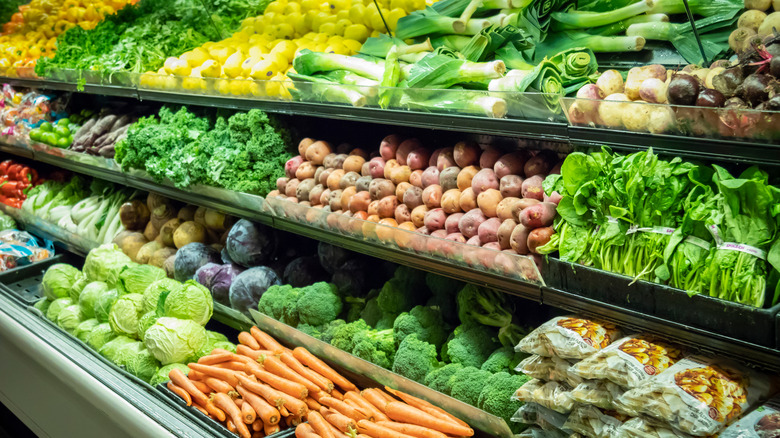How To Pick The Freshest Perishable Groceries Every Time
If you're interested in buying the freshest possible perishable food items available at your local grocery or supermarket — a category that includes fruits and vegetables as well as meat, fish, eggs, and other dairy products — there's a simple trick you need to learn.
To appreciate this hack, and why you should take advantage of it, it helps to understand how these stores are stocked. Groceries employ what's known as a FIFO (first in, first out) system. This method of inventory control ensures foods are rotated, with the oldest items always pushed to the front. The reason groceries and supermarkets utilize this system is obvious: It prevents perishable items like milk or produce from spoiling. Meaning, they're not getting stuck with food they can't sell.
For savvy shoppers, that means the freshest perishable food items aren't those that are placed right in front of them. Instead, the freshest foods are those at the very back of the shelf, fridge, or freezer. It's more difficult to reach them, naturally. That's by design on the part of grocery stores. But a quick perusal of expiration or use-by dates will show quite clearly that the farther back you're willing to reach, the fresher your food will be.
Why fresher foods are always better
Don't feel guilty about reaching all the way to the back to grab the freshest possible food. If the grocery has placed these items on shelves, they're available for purchase. Not only that but there are several very good reasons why opting for the freshest option is always preferable to the alternative.
Firstly, these foods stay fresh longer, so you're less likely to end up throwing away food that is spoiled or past its expiration date. Also notable, however, is that the freshest foods taste better, and may have more nutrition than older selections. One of the effects of oxidation on fresh produce — a result of aging — is that it exhausts the sugars and starches in these foods. The result is a diminishment of flavor. Vegetables, in particular, can develop more bitter notes as they start to lose freshness.
Decay in produce also saps nutrient levels of vitamins and minerals, often to a significant degree. According to research from the University of California at Davis, certain varieties of produce can lose more than 75% of nutrients after a single week of supermarket storage. Every day these fruits and vegetables are in the supermarket, in other words, they're losing flavor and nutrition.
Shopping for freshness at your local supermarket
Seeking out the freshest food shouldn't require much sacrifice in terms of the speed or convenience of shopping. For starters, supermarkets are designed around perishable items, which are almost always located along the perimeter of stores. So these items are easy to find, and in most cases, access. Sure, reaching to the back of produce bins or meat and dairy refrigerators may take a little more effort, but you'll be repaid for it with fresher, better-tasting food that will also last longer after purchase.
Pulling from the back, and checking use-by or expiration dates on meat, dairy, and some other perishable items is a great way to confirm you're getting the freshest possible products. But there are a few other shopping habits that can also help. One is ensuring that refrigerated products are the last grocery items you buy. Meat and dairy products, in particular, benefit from consistent temperature, so the sooner you can get them home and refrigerated again, the better.
It's also wise not to buy perishable grocery items on sale, as these discounts are often given for foods that are nearing their expiration dates. Meaning, they're no longer at optimal freshness.



